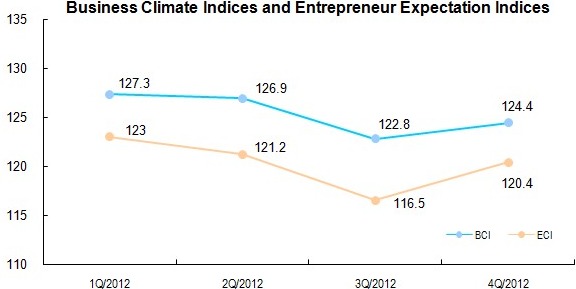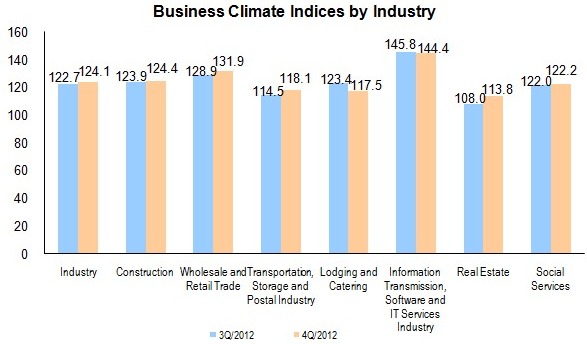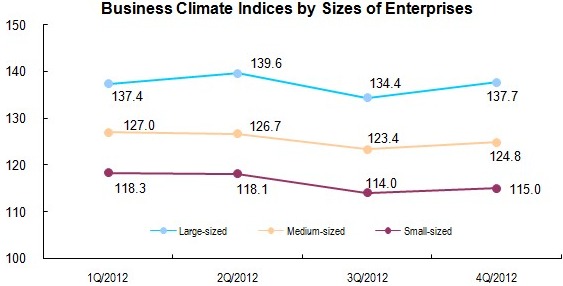China Economic Monitoring and Analysis Center (CEMAC): National Business Climate Survey results showed that the business climate index (BCI) was 124.4 in the fourth quarter, increased 1.6 points quarter-on-quarter. Of which, the current BCI that reflected the current state of business climate was 124.1, up by 4.4 points quarter-on-quarter; the expected BCI that reflected the anticipation of future business climate was 124.6, approximately flat compared with the third quarter level (slightly down by 0.2 points). In the fourth quarter, the entrepreneur expectation index (ECI) was 120.4, up by 3.9 points quarter-on-quarter.

In terms of sub-branches of the industry, the BCIs of production and supply of electricity, heat, gas and water, manufacturing, and mining industry was 141.4, 124.6 and 106.3 points, respectively. Of which, the industries with high prosperity from high to low in descending order were tobacco, pharmaceutical, beverage, food, agro-food processing, printing and electrical machinery, the BCIs were above 130. The industries with low prosperity from low to high in ascending order were ferrous metal mining and processing, petroleum processing, the BCIs were in a recession interval (the sentiment index is less than 100).

Survey results showed that in the fourth quarter, the BCIs of most industries picked up to varying degrees, and the prosperity gaps among different industries have narrowed. Overall, informatization and industrial upgrading-related industries such as IT services, equipment manufacturing industry, as well as consumption-related industries such as wholesale and retail trade, and food, pharmaceutical and appliances industry in the manufacturing sector continued to show a relatively high level of prosperity, while industries closely related to investment such as iron and steel, chemicals, non-ferrous metals, and cement industry continued to show a relatively low level of prosperity.
In terms of different types of registration, the BCIs of state-owned enterprises, collective-owned enterprises, joint-stock cooperative enterprises, joint ventures, limited liability companies, cooperation limited, private enterprises, enterprises with funds from Hong Kong, Macao, and Taiwan, and foreign funded enterprises was 129.2, 109.3, 118.6, 105.6, 121.3, 133.6, 119.3, 120.5 and 122.0 points in the fourth quarter, respectively. As compared with the results of the third quarter this year, the BCIs of joint-stock cooperative enterprises, limited liability companies, state-owned enterprises, private enterprises, foreign funded enterprises, and cooperation limited rose by 3.5, 2.6, 2.1, 1.7, 1.2 and 1.0 points respectively; that of joint ventures, collective-owned enterprises, enterprises with funds from Hong Kong, Macao, and Taiwan, dropped 7.2, 4.5 and 2.3 points respectively.
In terms of the sizes of enterprises, the BCIs of large, medium and small-sized enterprises were 137.1, 124.8 and 115.0, respectively, up by 2.7, 1.4 and 1.0 points quarter-on-quarter, respectively. Survey results showed that the prosperity level of large-sized enterprises rebounded relatively quickly, while that of small-sized enterprises rebounded relatively slow. The gaps among enterprises of different sizes were more obvious.

In terms of different regions, the BCI of central region was obviously higher than that of the eastern and western regions. In the third quarter, the BCIs of eastern, central and western regions stood at 123.8, 127.7 and 121.7, respectively.
Annotations:
1. Explanatory Notes
The business climate index is comprehensively reflects the economic situation and the expected direction, through out by the good or bad judgments on the business situation from the entrepreneurs from the business climate survey. The range of BCI is between 0-200, 100 as the critical value, when the index is greater than 100, reflecting the business climate state is good and optimistic, the more close to 200 the higher the level of optimism; less than 100, reflect the state of the business climate is poor and pessimistic, closer to 0 reflect deeper pessimistic.
The entrepreneur confidence index is comprehensively reflects the industry situation and the expected direction, through out by the good or bad judgments on the macro economic situation from the entrepreneurs from the business climate survey. The range of ECI is between 0-200, 100 as the critical value, when the index is greater than 100, reflecting the entrepreneur confidence state is good and optimistic, the more close to 200 the higher the level of optimism; less than 100, reflect the state of the entrepreneur confidence is poor and pessimistic, closer to 0 reflect deeper pessimistic.
2. Statistical Coverage
The survey covers eight sectors: industry, construction, wholesale and retail trade, transportation, storage and postal services, hotel and catering industry, information transmission, software and IT services, real estate, and social services. Each industry is according to the scale of the proportion of a sample.
3. Survey Methods
Samples were selected by adopting the sampling methods of stratified, probability proportional to size (PPS). The national total sample size were 21,000 enterprises.
4. Survey Contents
Survey involved in the business running, enterprises operation, profitability, employment, investment, financing, inventory and other production and management problems.
5. Calculation Methods
The business climate index = 0.4×Current BCI +0.6×Expected BCI
Current BCI = the proportion of good by the answer from the responsible persons in charge of the enterprise operating conditions in the current quarter - poor proportion of +100
Expected BCI = the proportion of good by the answer from the responsible persons in charge of the enterprise operating conditions in the next quarter - poor proportion of +100
The calculation method of ECI is similar to that of BCI.
6. Classification of Eastern, Central and Western Regions
Eastern regions including Beijing, Tianjin, Hebei, Liaoning, Shanghai, Jiangsu, Zhejiang, Fujian, Shandong, Guangdong, Hainan; central regions including Shanxi, Jilin, Heilongjiang, Anhui, Jiangxi, Henan, Hubei, Hunan; western regions including Inner Mongolia, Guangxi, Chongqing, Sichuan, Guizhou, Yunnan, Tibet, Shaanxi, Gansu, Qinghai, Ningxia, Xinjiang.